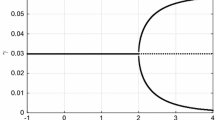Abstract
We build a model of R&D-based growth in which the discovery of higher-quality products is governed by sequential stochastic innovation contests. We term the costly attempts of incumbent firms to safeguard the monopoly rents from their past innovations rent-protecting activities. Our analysis (1) offers a novel explanation of the observation that the difficulty of conducting R&D has been increasing over time, (2) establishes the emergence of endogenous scale-invariant long-run innovation and growth, and (3) identifies a new structural barrier to innovation and growth. We also show that long-run growth depends positively on proportional R&D subsidies, the population growth rate, and the size of innovations, but negatively on the market interest rate and the effectiveness of rent-protecting activities.
Similar content being viewed by others
References
Anbarci N., Skaperdas S., Syropoulos C. (2002) Comparing bargaining solutions in the shadow of conflict: how norms against threats can have real effects. J. Econ. Theory 106, 1–16
Aghion P., Howitt P. (1992). A model of growth through creative destruction. Econometrica 60, 323–352
Arrow K. (1962). Economic welfare and the allocation of resources for inventions. In: Nelson R. (eds). The Rate and Direction of Inventive Activity. Princeton University Press, Princeton
Baumol W. (1993) Entrepreneurship, Management, and the Structure of Payoffs. The MIT Press, Cambridge
Cohen W., Goto A., Nagata A., Nelson N., Walsh J. (2002) R&D spillovers, patents and the incentives to innovate in Japan and the United States. Res. Policy 31, 1349–1367
Dinopoulos E., Segerstrom P. (1999) A Schumpeterian model of protection and relative wages. Am. Econ. Rev. 89, 450–472
Dinopoulos E., Sener F. (2006). New directions in Schumpeterian growth theory. In: Hanusch H., Pyka A. (eds). Edgar Companion to Neo Schumpeterian Economics. Edward Elgar Publishing, London
Dinopoulos E., Syropoulos C. (1998). International diffusion and appropriability of technological expertise. In: Baye M. (eds). Advances in Applied Microeconomics: Contests. JAI Press, Stamford CT
Dinopoulos, E., Syropoulos, C. Innovation and rent protection in the theory of Schumpeterian growth. Working Paper, Department of Economics, University of Florida (2003)
Eisenhardt K.M., Brown S.L. (1998) Time pacing: competing in markets that won’t stand still. Harvard Bus. Rev. 76, 59–69
Grossman G., Helpman E. (1991) Innovation and growth in the global economy. The MIT Press, Cambridge
Howitt P. (1999) Steady endogenous growth with population and R&D inputs growing. J. Polit. Econ. 107, 715–730
Jones C. (1995) Time-series tests of endogenous growth models. Q. J. Econ. 110, 495–525
Jones C. (1999) Growth: with or without scale effects. Am. Econ. Rev. Pap. Proc. 89, 141–144
Kortum S. (1997) Research, patenting, and technological change. Econometrica 65, 1389–1419
Lerner J. (1995) Patenting in the shadow of competitors. J. Law Econ. 38, 463–496
Levin R.C., Klevorick A.K., Nelson R.R., Winter S.G., Gilbert R., Griliches Z. (1987) Appropriating the returns of industrial R&D. Brookings Pap. Econ. Activity 1987, 783–820
Malliaris, A.G., Brock, W. Stochastic methods in economics and finance. North Holland, Amsterdam (1982)
Parente S., Prescott E. (1999) Monopoly rights: a barrier to riches. Am. Econ. Rev. 89, 1216–1233
Parente S., Prescott E. (2000) Barriers to riches. The MIT Press, Cambridge
Parente, S., Zhao, R. Slow development and special interests. Working Paper, Department of Economics, University of Illinois (2005)
Pecorino P. (1995) Review of Baumol, W., Entrepreneurship, management, and the structure of payoffs (1993). Public Choice 82, 389–392
Romer P. (1990) Endogenous technological change. J. Polit. Econ. 98, S71–S102
Rockett K. (1990) Choosing the competition and patent licensing. RAND J. Econ. 21, 161–171
Schumpeter J. (1934) The theory of economic development. Oxford University Press, Oxford
Segerstrom P. (1998) Endogenous growth without scale effects. Am. Econ. Rev. 88, 1290–1310
Segerstrom P., Anant T.C.A., Dinopoulos E. (1990) A Schumpeterian model of the product life cycle. Am. Econ. Rev. 80, 1077–1091
Skaperdas S. (1996) Contest success functions. Econ. Theory 7, 283–290
Skaperdas S., Syropoulos C. (2001) Guns, butter, and openness: on the relationship between security and trade. Am. Econ. Rev. Pap. Proc. 91, 353–357
Skaperdas S., Syropoulos C. (2002) Insecure property and the efficiency of exchange. Econ. J. 112, 133–146
Stolper W., Samuelson P. (1941) Protection and real wages. Rev. Econ. Stud. 9, 58–73
Tornell A. (1997) Economic growth and decline with endogenous property rights. J. Econ. Growth 2, 219–250
Tornell A., Lane P. (1999) The voracity effect. Am. Econ. Rev. 89, 22– 46
Van Long N., Sorger G. (2006) Insecure property rights and growth: the roles of appropriation costs, wealth effects, and heterogeneity. Econ. Theory 28, 512–529
Young A. (1998) Growth without scale effects. J. Polit. Econ. 106, 41–63
Author information
Authors and Affiliations
Corresponding author
Additional information
An unpublished version of this paper was circulated earlier under the title “Innovation and Rent Protection in the Theory of Schumpeterian Growth.” We thank an anonymous referee and seminar participants in several venues for useful comments and suggestions.
Rights and permissions
About this article
Cite this article
Dinopoulos, E., Syropoulos, C. Rent Protection as a Barrier to Innovation and Growth. Economic Theory 32, 309–332 (2007). https://doi.org/10.1007/s00199-006-0124-4
Received:
Accepted:
Published:
Issue Date:
DOI: https://doi.org/10.1007/s00199-006-0124-4




